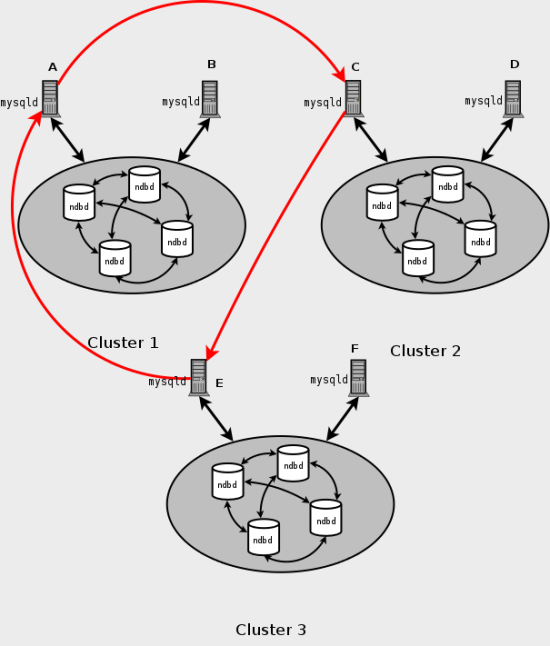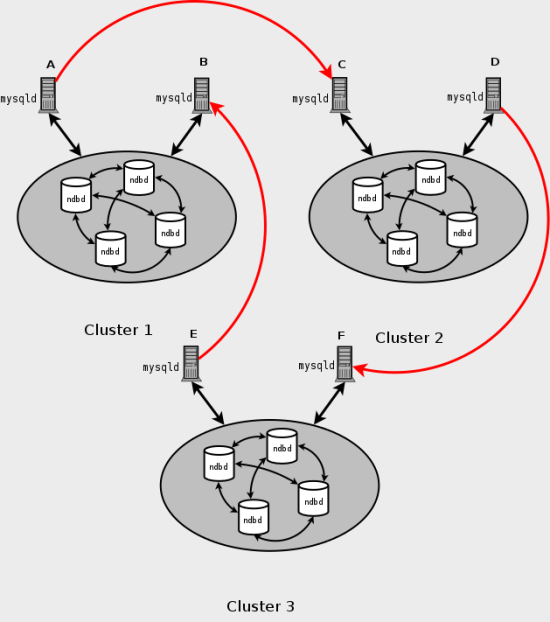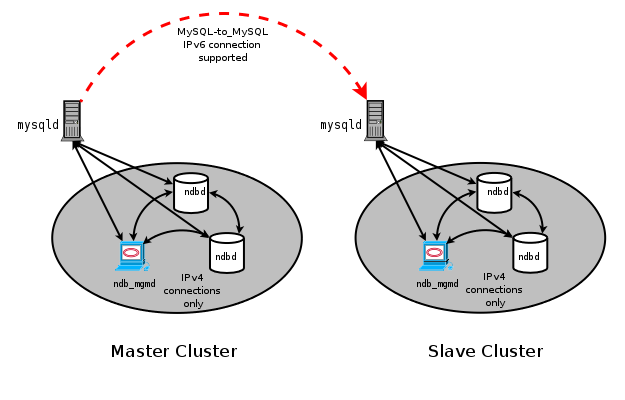- 17.6 MySQL Cluster Replication
- 17.6.1 MySQL Cluster Replication — Abbreviations and Symbols
- 17.6.2 MySQL Cluster Replication — Assumptions and General Requirements
- 17.6.3 Known Issues in MySQL Cluster Replication
- 17.6.4 MySQL Cluster Replication Schema and Tables
- 17.6.5 Preparing the MySQL Cluster for Replication
- 17.6.6 Starting MySQL Cluster Replication (Single Replication Channel)
- 17.6.7 Using Two Replication Channels for MySQL Cluster Replication
- 17.6.8 Implementing Failover with MySQL Cluster Replication
- 17.6.9 MySQL Cluster Backups With MySQL Cluster Replication
- 17.6.10 MySQL Cluster Replication — Multi-Master and Circular Replication
- 17.6.11 MySQL Cluster Replication Conflict Resolution
The following are known problems or issues when using replication with MySQL Cluster in MySQL 5.1 (including MySQL Cluster NDB 6.X and 7.X through 7.1):
-
Loss of master-slave connection. A loss of connection can occur either between the replication master SQL node and the replication slave SQL node, or between the replication master SQL node and the data nodes in the master cluster. In the latter case, this can occur not only as a result of loss of physical connection (for example, a broken network cable), but due to the overflow of data node event buffers; if the SQL node is too slow to respond, it may be dropped by the cluster (this is controllable to some degree by adjusting the
MaxBufferedEpochsandTimeBetweenEpochsconfiguration parameters). If this occurs, it is entirely possible for new data to be inserted into the master cluster without being recorded in the replication master's binary log. For this reason, to guarantee high availability, it is extremely important to maintain a backup replication channel, to monitor the primary channel, and to fail over to the secondary replication channel when necessary to keep the slave cluster synchronized with the master. MySQL Cluster is not designed to perform such monitoring on its own; for this, an external application is required.Prior to MySQL 5.1.18, a MySQL Cluster replication slave mysqld had no way of detecting that the connection from the master had been interrupted. For this reason, it was possible for the slave to become inconsistent with the master.
Beginning with MySQL 5.1.18, the replication master issues a “gap” event when connecting or reconnecting to the master cluster. (A gap event is a type of “incident event,” which indicates an incident that occurs that affects the contents of the database but that cannot easily be represented as a set of changes. Examples of incidents are server crashes, database resynchronization, (some) software updates, and (some) hardware changes.) When the slave encounters a gap in the replication log, it stops with an error message. This message is available in the output of
SHOW SLAVE STATUS, and indicates that the SQL thread has stopped due to an incident registered in the replication stream, and that manual intervention is required. See Section 17.6.8, “Implementing Failover with MySQL Cluster Replication”, for more information about what to do in such circumstances.Important
Because MySQL Cluster is not designed on its own to monitor replication status or provide failover, if high availability is a requirement for the slave server or cluster, then you must set up multiple replication lines, monitor the master mysqld on the primary replication line, and be prepared fail over to a secondary line if and as necessary. This must be done manually, or possibly by means of a third-party application. For information about implementing this type of setup, see Section 17.6.7, “Using Two Replication Channels for MySQL Cluster Replication”, and Section 17.6.8, “Implementing Failover with MySQL Cluster Replication”.
However, if you are replicating from a standalone MySQL server to a MySQL Cluster, one channel is usually sufficient.
Multi-byte character sets. Previously, there were several known issues with regard to the use of multi-byte characters sets with MySQL Cluster Replication. These were resolved in MySQL 5.1.21, MySQL Cluster NDB 6.2.14, and MySQL Cluster NDB 6.3.11. (See Bug#27404 and Bug#29562.)
-
Circular replication. Prior to MySQL 5.1.18, circular replication was not supported with MySQL Cluster replication, due to the fact that all log events created in a particular MySQL Cluster were wrongly tagged with the server ID of the MySQL server used as master and not with the server ID of the originating server.
Beginning with MySQL 5.1.18, this limitation is lifted, as discussed in the next few paragraphs, in which we consider the example of a replication setup involving three MySQL Clusters numbered 1, 2, and 3, in which Cluster 1 acts as the replication master for Cluster 2, Cluster 2 acts as the master for Cluster 3, and Cluster 3 acts as the master for Cluster 1. Each cluster has two SQL nodes, with SQL nodes A and B belonging to Cluster 1, SQL nodes C and D belonging to Cluster 2, and SQL nodes E and F belonging to Cluster 3.
Circular replication using these clusters is supported as long as:
The SQL nodes on all masters and slaves are the same
All SQL nodes acting as replication masters and slaves are started using the
--log-slave-updatesoption
This type of circular replication setup is shown in the following diagram:

In this scenario, SQL node A in Cluster 1 replicates to SQL node C in Cluster 2; SQL node C replicates to SQL node E in Cluster 3; SQL node E replicates to SQL node A. In other words, the replication line (indicated by the red arrows in the diagram) directly connects all SQL nodes used as replication masters and slaves.
It should also be possible to set up circular replication in which not all master SQL nodes are also slaves, as shown here:

In this case, different SQL nodes in each cluster are used as replication masters and slaves. However, you must not start any of the SQL nodes using
--log-slave-updates(see the description of this option for more information). This type of circular replication scheme for MySQL Cluster, in which the line of replication (again indicated by the red arrows in the diagram) is discontinuous, should be possible, but it should be noted that it has not yet been thoroughly tested and must therefore still be considered experimental.Note
Beginning with MySQL 5.1.24, the
NDBstorage engine uses idempotent execution mode, which suppresses duplicate-key and other errors that otherwise break circular replication of MySQL Cluster. This is equivalent to setting the globalslave_exec_modesystem variable toIDEMPOTENT. This is also required for multi-master replication when using MySQL Cluster. (Bug#31609)It is not necessary to set
slave_exec_modein MySQL Cluster replication; MySQL Cluster does this automatically for allNDBtables and ignores any attempts to set this variable explicitly. Cluster replication and primary keys. In MySQL 5.1.6, only those
NDBtables having explicit primary keys could be replicated. This limitation was lifted in MySQL 5.1.7. However, in the event of a node failure, errors in replication ofNDBtables without primary keys can still occur, due to the possibility of duplicate rows being inserted in such cases. For this reason, it is highly recommended that allNDBtables being replicated have primary keys.Restarting with
--initial. Restarting the cluster with the--initialoption causes the sequence of GCI and epoch numbers to start over from0. (This is generally true of MySQL Cluster and not limited to replication scenarios involving Cluster.) The MySQL servers involved in replication should in this case be restarted. After this, you should use theRESET MASTERandRESET SLAVEstatements to clear the invalidndb_binlog_indexandndb_apply_statustables. respectively.auto_increment_offsetandauto_increment_incrementvariables. The use of theauto_increment_offsetandauto_increment_incrementserver system variables is supported beginning with MySQL 5.1.20. Previously, these produced unpredictable results when used withNDBtables or MySQL Cluster replication.-
Replication from
NDBCLUSTERto other storage engines. If you attempt to replicate from a MySQL Cluster to a slave that uses a storage engine that does not handle its own binary logging, the replication process aborts with the error Binary logging not possible ... Statement cannot be written atomically since more than one engine involved and at least one engine is self-logging (Error 1595). It is possible to work around this issue in one of the following ways:Turn off binary logging on the slave. This can be accomplished by setting
sql_log_bin = 0.Change the storage engine used for the
mysql.ndb_apply_statustable. Causing this table to use an engine that does not handle its own binary logging can also eliminate the conflict. This can be done by issuing a statement such asALTER TABLE mysql.ndb_apply_status ENGINE=MyISAMon the slave. It is safe to do this when using a non-NDBstorage engine on the slave, since you do not then need to worry about keeping multiple slave SQL nodes synchronized.Filter out changes to the
mysql.ndb_apply_statustable on the slave. This can be done by starting the slave SQL node with the option--replicate-ignore-table=mysql.ndb_apply_status. If you need for other tables to be ignored by replication, you might wish to use an appropriate--replicate-wild-ignore-tableoption instead.
Important
You should not disable replication or binary logging of
mysql.ndb_apply_statusor change the storage engine used for this table when replicating from one MySQL Cluster to another. See Replication and binary log filtering rules with replication between MySQL Clusters elsewhere in this section for details. -
Replication from
NDBto a different storage engine. For replication fromNDBto a different storage engine, the relationship between the two databases must be a simple master-slave one. This means that circular or master-master replication is not supported between MySQL Cluster and other storage engines. However, the MySQL Cluster database can simultaneously replicate to multiple slave MySQL Cluster databases.In addition, it is not possible to configure more than one replication channel when replicating between MySQL Cluster and a different storage engine. If MySQL Cluster is the master then it is still possible to have more than one MySQL Server maintain a binary log of all changes; however, for the slave to change masters (fail over), the new master-slave relationship must be explicitly defined on the slave.
-
Replication from
NDBto a nontransactional storage engine. When replicating fromNDBto a nontransactional storage engine such asMyISAM, you may encounter unnecessary duplicate key errors when replicatingINSERT ... ON DUPLICATE KEY UPDATEstatements. You can suppress these in MySQL Cluster NDB 6.2 by using--ndb-log-update-as-write=0, which forces updates to be logged as writes (rather than as updates).You should also be aware that, when replicating from
NDBto a storage engine that does not implement transactions (such asMyISAM), if the slave fails in applying one or more rows changes from a transaction, it does not roll back the rest of the transaction. Because of this, it cannot be guaranteed that transactional consistency will be maintained on the slave in this type of scenario. -
Replication and binary log filtering rules with replication between MySQL Clusters. If you are using any of the options
--replicate-do-*,--replicate-ignore-*,--binlog-do-db, or--binlog-ignore-dbto filter databases or tables being replicated, care must be taken not to block replication or binary logging of themysql.ndb_apply_status, which is required for replication between MySQL Clusters to operate properly. In particular, you must keep in mind the following:-
Using
--replicate-do-db=(and no otherdb_name--replicate-do-*or--replicate-ignore-*options) means that only tables in databasedb_nameare replicated. In this case, you should also use--replicate-do-db=mysql,--binlog-do-db=mysql, or--replicate-do-table=mysql.ndb_apply_statusto ensure thatmysql.ndb_apply_statusis populated on slaves.Using
--binlog-do-db=(and no otherdb_name--binlog-do-dboptions) means that changes only to tables in databasedb_nameare written to the binary log. In this case, you should also use--replicate-do-db=mysql,--binlog-do-db=mysql, or--replicate-do-table=mysql.ndb_apply_statusto ensure thatmysql.ndb_apply_statusis populated on slaves. -
Using
--replicate-ignore-db=mysqlmeans that no tables in themysqldatabase are replicated. In this case, you should also use--replicate-do-table=mysql.ndb_apply_statusto ensure thatmysql.ndb_apply_statusis replicated.Using
--binlog-ignore-db=mysqlmeans that no changes to tables in themysqldatabase are written to the binary log. In this case, you should also use--replicate-do-table=mysql.ndb_apply_statusto ensure thatmysql.ndb_apply_statusis replicated.
You should also remember that:
Each replication filtering rule requires its own
--replicate-do-*or--replicate-ignore-*option, and that multiple rules cannot be expressed in a single replication filtering option. For information about these rules, see Section 16.1.3, “Replication and Binary Logging Options and Variables”.Each binary log filtering rule requires its own
--binlog-do-dbor--binlog-ignore-dboption, and that multiple rules cannot be expressed in a single binary log filtering option. For information about these rules, see Section 5.2.4, “The Binary Log”.
Note
If you are replicating a MySQL Cluster to a slave that uses a storage engine other than
NDBCLUSTER, the considerations just given previously may not apply. See Replication fromNDBCLUSTERto other storage engines elsewhere in this section for details. -
-
MySQL Cluster Replication and IPv6. Currently, the NDB API and MGM API do not support IPv6. However, beginning with MySQL Cluster NDB 6.4.1, MySQL Servers — including those acting as SQL nodes in a MySQL Cluster — can use IPv6 to contact other MySQL Servers. This means that you can replicate between MySQL Clusters using IPv6 to connect the master and slave SQL nodes as shown by the dotted arrow in the following diagram:

However, all connections originating within the MySQL Cluster — shown in the diagram by solid arrows — must use IPv4.
All MySQL Cluster data nodes, management servers, and management clients must be accessible from one another using IPv4. In addition, SQL nodes must use IPv4 to communicate with the cluster. There is not currently any support in the NDB and MGM APIs for IPv6, which means that any applications written using these APIs must also make all connections using IPv4.
-
Attribute promotion and demotion. Formerly, support in MySQL Cluster for type conversions between columns of similar but different types on the master and the slave was extremely limited. However, starting with MySQL Cluster NDB 6.3.33, 7.0.14, and 7.1.3, MySQL Cluster Replication includes support for attribute promotion and demotion. The implementation of the latter distinguishes between lossy and non-lossy type conversions, and their use on the slave can be controlled by setting the
slave_type_conversionsglobal server system variable.For more information about attribute promotion and demotion in MySQL Cluster, see Attribute promotion and demotion (MySQL Cluster).

User Comments
Add your own comment.